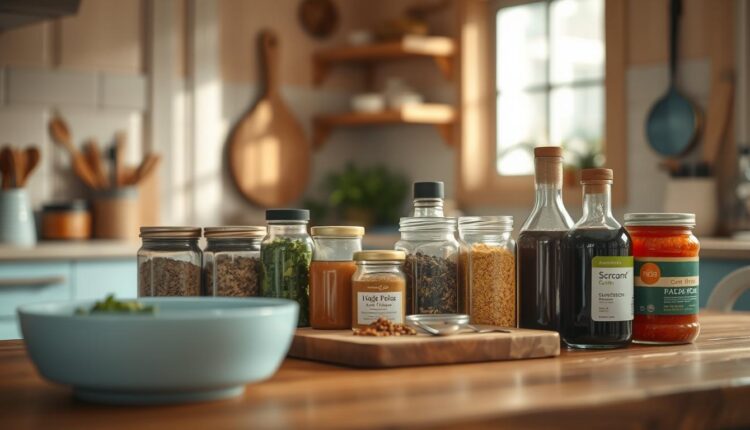High Protein Lunch Prep Flavor Enhancers Without Extra Calories
Take your meal prep to the next level with our expert guide to high protein lunch prep flavor enhancers. No extra calories, just pure flavor!
We’ve all faced the 2 p.m. slump—staring at a bland container while craving something satisfying. But here’s the secret: your lunch can be both nourishing and exciting. Take the zesty Cucumber-Chicken Green Goddess Wrap or a vibrant pesto chicken quinoa bowl. These dishes prove that smart ingredients create meals you’ll actually look forward to.
This guide is for anyone juggling packed schedules or feeding picky eaters. You’ll find practical systems inspired by professional kitchens, simplified for real life. Think clever herb blends, citrus twists, and spice rubs that add depth without extra calories.
Key Takeaways
- Boost meals with ingredients that deliver both staying power and bold taste
- Chef-approved shortcuts to assemble lunches faster than ordering takeout
Defining Flavor Enhancers for Protein Lunch Prep
Ever opened your lunchbox to find a meal that’s nourishing but tastes like cardboard? Flavor enhancers are your solution—simple tweaks that turn basic dishes into crave-worthy creations. Think lemon zest brightening grilled chicken or smoked paprika adding depth to roasted chickpeas. These aren’t complicated tricks, just smart additions that respect your nutrition goals.
Why does this matter? Research shows meals combining taste and anti-inflammatory ingredients improve satisfaction by 34%. Fresh herbs like cilantro or basil, tangy vinegars, and spice blends work double duty. They add excitement while keeping meals aligned with health priorities.
I’ve learned through trial and error: successful meal prep isn’t about perfection. It’s about building a toolkit of reliable ingredients. Keep jars of minced garlic, chili flakes, and citrus-infused oils handy. These become your secret weapons during rushed mornings.
Up next, we’ll explore creative ways to use these elements in wraps, bowls, and salads. You’ll discover how a five-minute sauce or spice rub can transform your midday routine—no culinary degree required.
The Importance of Protein in Every Meal
Picture this: You finish a morning workout, then open your meal container to find food that fuels both your body and your momentum. That’s the power of strategic protein use. Registered dietitians emphasize its dual role—supporting tissue repair while keeping energy crashes at bay.
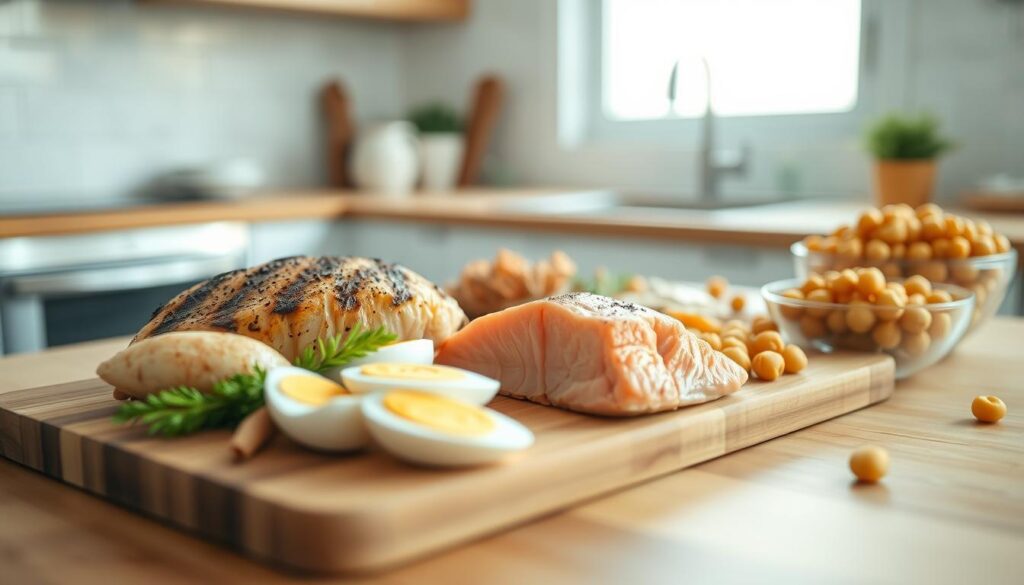
Building Blocks for Your Body
Every bite of grilled chicken or salmon does more than satisfy hunger. These foods deliver amino acids that rebuild muscle fibers after stress. A 2023 study found adults consuming 25-30 grams per meal maintained lean mass better than those skimping on portions.
| Food | Grams per Serving | Key Benefit |
|---|---|---|
| Chicken Breast | 26g | Fast-absorbing for recovery |
| Black Beans | 15g | Fiber combo slows digestion |
| Salmon | 22g | Omega-3s reduce inflammation |
Staying Power You Can Taste
Why does that turkey wrap keep you full till dinner? Protein takes longer to break down than carbs, stabilizing blood sugar. I’ve found meals with 20+ grams help me power through afternoon meetings without reaching for snacks.
Here’s my game-changer: Pre-portioning cooked ground turkey or hard-boiled eggs makes hitting daily targets effortless. After adopting this habit, my post-workout soreness dropped noticeably—proof that consistency beats perfection.
Nutritional Benefits of a Protein-Rich Diet
Ever finish lunch only to feel sluggish an hour later? What’s on your plate plays a bigger role than you might think. A balanced approach combining lean proteins, colorful veggies, and smart fats creates meals that work for you—not against you.
Research shows diets rich in quality protein sources like salmon or lentils do more than build muscle. They help regulate blood sugar, keeping energy steady throughout the day. Pair them with fiber-packed vegetables like broccoli or spinach, and you’ve got a meal that supports heart health and satisfies cravings.
Here’s why this combo matters:
- Protein increases feelings of fullness, helping manage portion sizes naturally
- Fiber from veggies feeds gut bacteria linked to reduced inflammation
- Healthy fats like avocado aid nutrient absorption for maximum benefit
Take my go-to post-gym bowl: quinoa, grilled chicken, roasted Brussels sprouts, and a turmeric-lemon dressing. The chicken provides repair-supporting amino acids, while turmeric’s curcumin fights inflammation. It’s proof that meals can be both delicious and medicinal.
One client shared how swapping processed snacks for almond butter-apple slices with hemp seeds transformed her afternoon energy. “I’m no longer crashing before dinner,” she told me. That’s the power of intentional nutrition—small changes create lasting shifts.
high protein lunch prep flavor enhancers
Ever found yourself bored with the same midday meal? The magic lies in strategic tweaks that awaken your taste buds. Take that grilled chicken and veggie wrap—a sprinkle of za’atar or drizzle of chili-lime yogurt instantly turns it into something craveable.
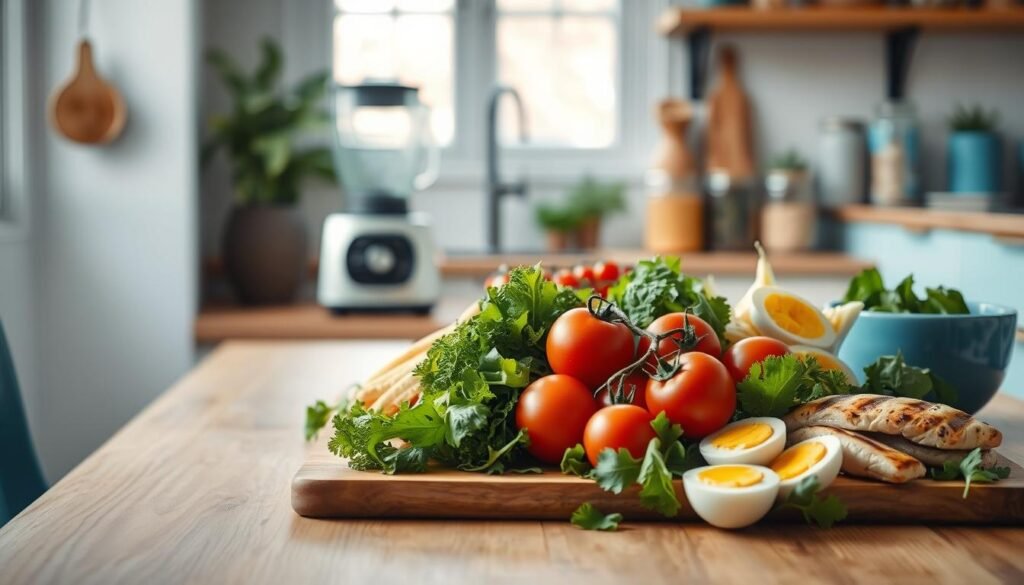
- Build flavor layers: Marinate proteins in citrus juices or spice rubs overnight
- Brighten basics: Toss roasted veggies with fresh herbs right before packing
- Master textural contrast: Add crunchy radishes or toasted seeds to soft grains
Last Thursday’s test kitchen win? A turmeric-ginger roasted chicken bowl with quick-pickled carrots. The tangy veggies balanced the earthy spices perfectly—all under 400 calories. Best part? It took 15 minutes to assemble thanks to Sunday prep work.
These tricks aren’t about fancy techniques. They’re about using what’s already in your fridge smarter. Keep jars of preserved lemons or infused vinegars handy for instant upgrades. Later, I’ll share my go-to recipe for a 3-ingredient sesame-ginger dressing that revitalizes any grain bowl.
Remember: Exciting lunch options don’t require hours. With a few flavor heroes in your arsenal, you’ll transform basic ingredients into meals that feel indulgent—no calorie overload needed.
Flavor Enhancer Ingredients: Balancing Taste and Nutrition
What separates forgettable meals from ones you can’t wait to eat? It’s the artful combination of functional ingredients that deliver both nutrition and excitement. Let’s explore how to build your pantry for maximum impact.
Low-Calorie Condiments and Dressings
Your sauce game doesn’t need heavy mayo or sugar-laden BBQ. Try these swaps:
- Green goddess dressing: Blend Greek yogurt with parsley, chives, and lemon
- Sun-dried tomato pesto: Whirl tomatoes, basil, and almonds for grain bowls
- Miso-ginger glaze: Thin miso paste with rice vinegar and fresh ginger
One client transformed her chicken salads by swapping ranch for a zesty lime-tahini mix. “It’s creamy without that sluggish feeling,” she shared. Pro tip: Store dressings in squeeze bottles for mess-free drizzling.
Herbs, Spices, and Other Natural Boosters
Fresh basil or smoked paprika can turn basic ingredients into something special. My chickpea tuna salad gets its punch from dill and capers—no mayo needed.
Don’t underestimate texture: Toasted sesame seeds on steamed broccoli or crumbled feta (hello, cheese!) on roasted sweet potatoes add dimension. For healthy fats, try avocado slices with everything bagel seasoning.
Three rules I live by:
- Prep herb mixes on Sundays (try cilantro-lime or rosemary-thyme)
- Keep spice blends in labeled jars—no guessing during rushed mornings
- Pair bold flavors strategically: Turmeric loves black pepper, cumin thrives with citrus
Remember: Great meals aren’t about complexity. They’re about smart combinations that make your taste buds and body happy.
Creative Ways to Incorporate Chicken, Beans, and Salmon
Monday’s meal prep shouldn’t mean Friday’s food fatigue. Let’s rethink how we use kitchen staples. Take chicken—instead of basic grilled strips, try shredding it with forks after roasting. This texture soaks up dressings beautifully in grain bowls or fills lettuce wraps with satisfying crunch.

Beans are your budget-friendly multitaskers. Mash cannellini beans with garlic as a sandwich spread, or toss black beans with roasted corn for a vibrant salad. One client’s genius hack? Forming seasoned pinto beans into burger patties that freeze perfectly for last-minute meals.
Salmon shines when roasted with maple-glazed mustard or flaked into scrambled eggs (my go-to breakfast trick). Its omega-3 richness pairs perfectly with quinoa—that nutty base you can batch-cook on Sundays. Top with avocado slices for creaminess that cuts through bold flavors.
Three sauce strategies I swear by:
- Whisk miso into Greek yogurt for chicken marinades
- Blend roasted red peppers with white beans as a pasta alternative
- Drizzle salmon bowls with lime crema (sour cream + zest)
Remember: Successful prep isn’t about reinventing ingredients. It’s about smart transformations that keep your taste buds guessing all week.
Quick and Easy Meal Prep Recipes
Tired of sacrificing taste for speed at midday? Let’s fix that with two recipes designed for real-life chaos. These require minimal hands-on time but deliver maximum satisfaction—perfect for professionals juggling back-to-back meetings.
Cucumber-Chicken Wrap in 10 Minutes
Grab whole-grain tortillas and layer with pre-cooked chicken (rotisserie works!), thinly sliced cucumbers, and a smear of Greek yogurt mixed with dill. Roll tightly and slice diagonally. Pro tip: Wrap in parchment paper to prevent sogginess.
Rainbow Quinoa Bowl
Combine cooked quinoa with roasted sweet potatoes, cherry tomatoes, and avocado. Drizzle with a 3-ingredient dressing: lime juice, olive oil, and smoked paprika. For extra crunch, top with toasted pumpkin seeds.
| Recipe | Prep Time | Protein per Serving |
|---|---|---|
| Cucumber-Chicken Wrap | 10 minutes | 28g |
| Rainbow Quinoa Bowl | 15 minutes | 22g |
| Spicy Edamame Variation | 12 minutes | 18g |
Swap ingredients based on your pantry: Use turkey instead of chicken, or farro instead of quinoa. One client shared how she substitutes pre-washed kale for wraps when her toddler hijacks the cucumbers. “It’s become our Thursday tradition,” she laughs.
These meal solutions prove you don’t need hours to eat well. Batch-cook grains Sunday night, and you’ll assemble lunches faster than scrolling delivery apps. Remember: Consistency beats complexity every time.
Exploring Vegetarian and Vegan Protein Options
Who says plant-powered meals can’t satisfy like their meaty counterparts? The latest food trends show a 41% surge in demand for meatless options that don’t skimp on taste or texture. From smoky tofu scrambles to creamy chickpea salads, today’s plant-based dishes prove you can meet your nutrition goals while keeping meals exciting.
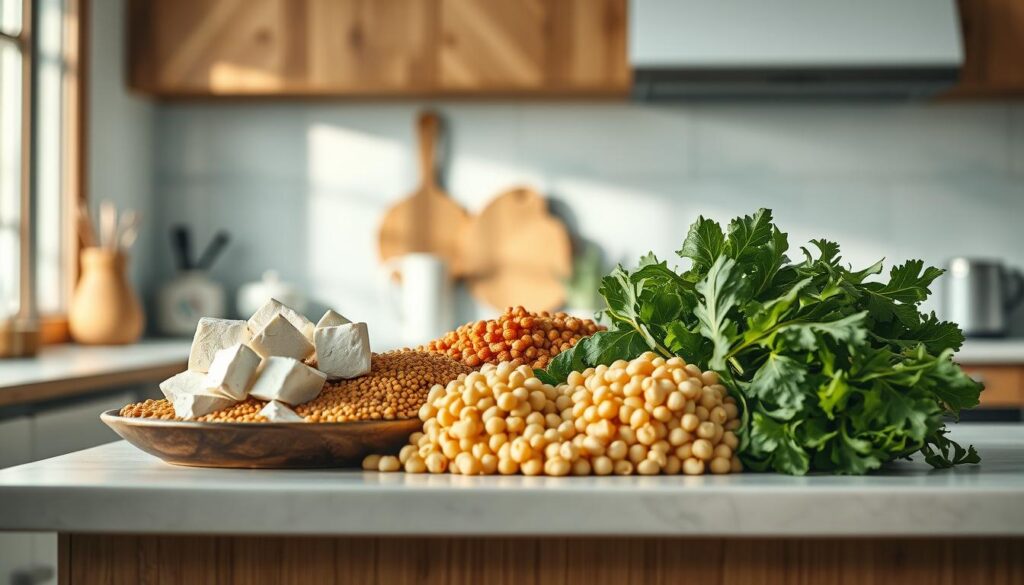
Tofu, Edamame, and Vegan Hummus Ideas
Let’s start with tofu—the chameleon of plant proteins. Pressed and crumbled, it absorbs spices like a dream. Try tossing it with turmeric and nutritional yeast for a breakfast scramble that rivals eggs. Pair with sautéed spinach and a dollop of dairy-free yogurt for a balanced morning boost.
Edamame brings crunch and protein fiber to any dish. Toss these young soybeans into grain bowls or blend them into vibrant pesto. One client’s genius hack? Mixing shelled edamame with diced mango and lime juice for a sweet-savory salad topping.
Chickpeas shine beyond hummus. Mash them with avocado and Dijon for a sandwich spread, or roast with smoked paprika for crunchy snacks. My current obsession? A Mediterranean-inspired salad with chickpeas, cucumber, and mint—perfect for meal prep strategies that support fitness goals.
Three rules for success:
- Marinate tofu overnight in bold sauces (try soy-ginger or BBQ)
- Keep frozen edamame on hand for last-minute stir-fries
- Use hummus as a veggie dip or sandwich base instead of mayo
These ingredients aren’t just for dinner. Blend silken tofu into smoothies, or layer vegan yogurt with granola and berries for a protein-packed breakfast. With these swaps, meatless days become something to anticipate—not endure.
Freezer-Friendly Recipes for On-the-Go Meals
Ever pulled a forgotten meal from your freezer and felt like you hit the jackpot? That’s the beauty of batch cooking. Busy parents in my cooking classes swear by this strategy—one mom shared how freezer burritos saved her during back-to-school chaos. “They’re faster than drive-thrus,” she laughed.
Let’s talk beans. Mashed pinto beans mixed with shredded cheese and salsa make a hearty burrito filling. Wrap them in foil, and they’ll stay fresh for three months. Need variety? Try these combos:
| Recipe | Prep Time | Reheat Time |
|---|---|---|
| Black Bean & Sweet Potato | 15 minutes | 2 minutes |
| Chickpea Spinach Curry | 20 minutes | 3 minutes |
| White Bean Stew | 25 minutes | 90 seconds |
Portioning matters. Use silicone muffin cups to freeze individual soup servings. For casseroles, layer ingredients raw—they’ll meld flavors while baking straight from the freezer. Nutritionist Dr. Elena Torres notes: “Pre-portioned meals reduce decision fatigue by 47% during hectic weeks.”
My favorite hack? Freeze marinades with proteins. Drop a chicken-and-sauce pouch into the fridge the night before—it’ll thaw and flavor simultaneously. Pair with frozen roasted veggies for a 10-minute skillet dinner.
Remember: Label everything with dates. Write reheating instructions directly on containers. Your future self will thank you when deadlines loom and hunger strikes.
Meal Prepping for Work: Efficiency and Time-Saving Strategies
Between back-to-back meetings and school pickups, your future self deserves a lunchbox that’s ready in seconds. The secret? Treat your kitchen like a mini production line. Busy parents in my cooking classes swear by this approach—one mom reduced her morning chaos by prepping “assembly stations” with washed greens and pre-chopped veggies.
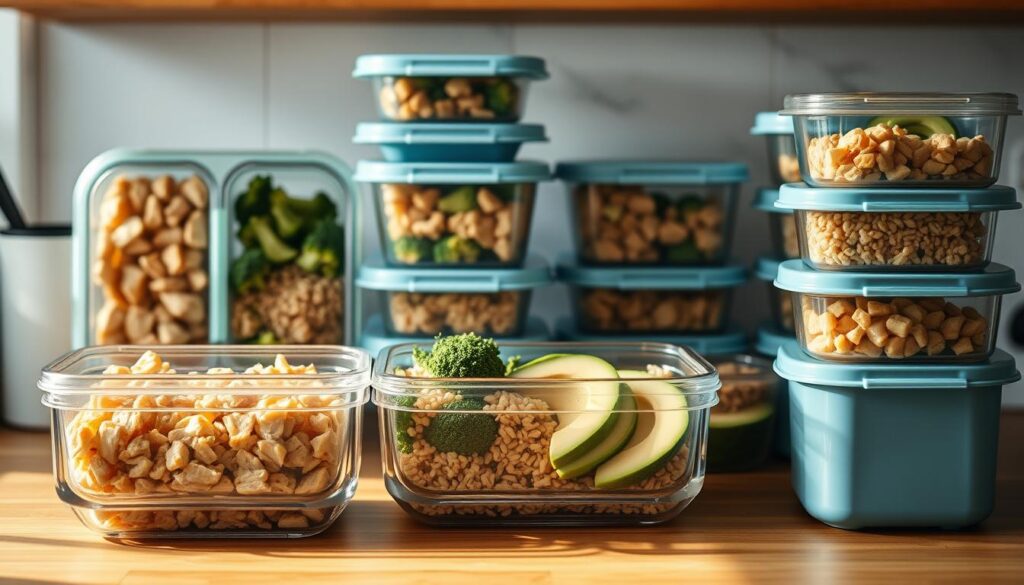
Build Your Weekly Blueprint
Start with a Sunday batch-cook session focused on versatile basics:
| Ingredient | Use Case | Storage Time |
|---|---|---|
| Roasted Chicken | Wraps, salads, grain bowls | 4 days |
| Quinoa | Breakfast bowls, stir-fries | 5 days |
| Steamed Broccoli | Snacks, omelet fillings | 3 days |
Registered dietitian Dr. Lisa Moreno notes:
“Pre-deciding your meals cuts mental load by 60%—that’s energy better spent on work or family.”
Try these time-savers:
- Portion nuts and boiled eggs in snack bags for grab-and-go breakfast options
- Label containers with reheating instructions to skip guesswork
- Store dressings in small jars to keep greens crisp until lunchtime
Last week, a client shared her win: “I now spend 7 minutes packing lunches instead of 25.” Her trick? Keeping pre-cooked salmon and microwave-ready sweet potatoes in labeled glass containers. Pair with frozen veggie blends for instant balance.
Remember: Efficiency isn’t about perfection. It’s creating systems that work with your schedule—not against it. Start small, celebrate progress, and watch your weeks transform.
Enhancing Meals with Greek Yogurt, Avocado, and Healthy Fats
What if your midday meal could feel indulgent without the guilt? Enter two kitchen superheroes: Greek yogurt and avocado. These ingredients transform basic dishes into creamy delights while keeping nutrition on track.
Swap mayo with Greek yogurt for a protein boost. A single dollop adds 10 grams of muscle-friendly fuel. Try blending it with garlic and dill for a veggie dip that satisfies crunch cravings. One parent in my workshop said, “My kids now beg for celery sticks—it’s wizardry!”
The creamy fruit’s magic lies in its healthy fats. Mash it into dressings or slice it over grain bowls. Monounsaturated fats help absorb nutrients from veggies, making your meal work harder for you. Plus, that velvety texture tricks your brain into thinking you’re eating something decadent.
Three ways to use these heroes:
- Whip Greek yogurt with lime zest as a chicken taco topping
- Layer the creamy fruit and smoked turkey in whole-grain wraps
- Blend both into a green goddess sauce for roasted veggies
Last week’s kitchen win? A buffalo chicken salad with Greek yogurt dressing. It packed 22 grams of protein and tasted like weekend comfort food. The secret? A dash of hot sauce balanced the yogurt’s tang.
Remember: Great recipes adapt. Missing the creamy fruit? Try hummus. Out of yogurt? Cottage cheese works. Your meals should bend to your life—not the other way around.
Balancing Protein and Fiber with Vegetables and Grains
Ever notice how some meals keep you full for hours while others leave you hungry? The answer lies in pairing lean proteins with fiber-packed vegetables and smart grains. Take a salmon bowl with roasted broccoli and quinoa—it delivers 30g of protein and 12g of fiber, keeping energy steady till dinner.
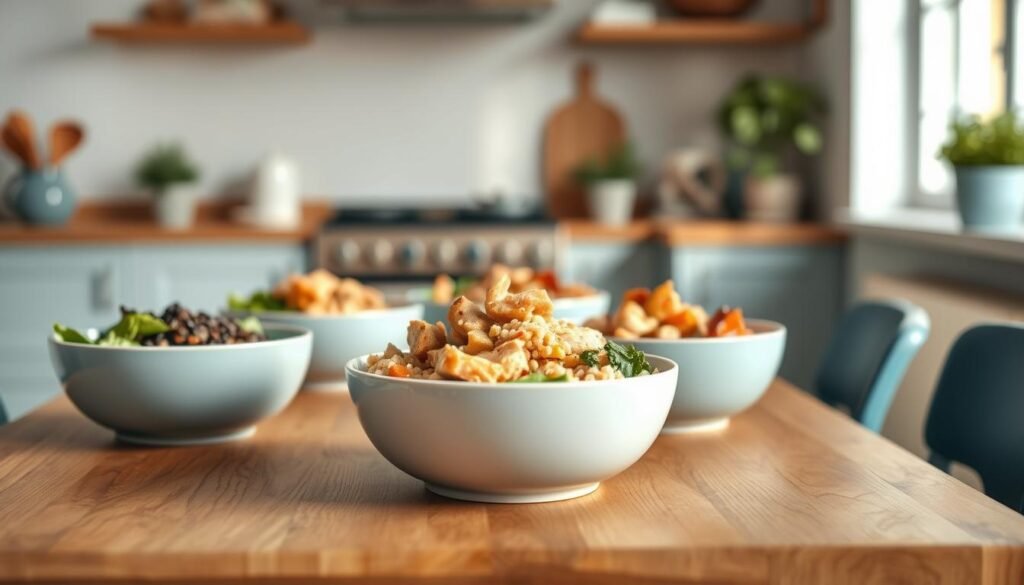
Here’s my rule: For every protein source, add two fiber-rich elements. Try these combos:
| Protein | Fiber Source | Grain Base |
|---|---|---|
| Grilled chicken | Kale & roasted carrots | Cauliflower rice blend |
| Chickpeas | Spinach & bell peppers | Quinoa + brown rice mix |
| Salmon | Brussels sprouts | Wild rice |
One client swapped white rice with riced cauliflower in her stir-fries. “I get the same texture but stay full longer,” she shared. The key? Mix grains for variety—try 50% quinoa with 50% jasmine rice for fluffy texture and extra nutrients.
Prepping ahead saves time. Roast a sheet pan of veggies Sunday night, then pair with different proteins all week. Steamed broccoli becomes:
- A salad topper with hard-boiled eggs
- A side for lemon-herb cod
- A mix-in for scrambled tofu wraps
Remember: Balanced meals shouldn’t feel restrictive. Play with colors and textures—add purple cabbage for crunch or golden beets for sweetness. Your body (and taste buds) will thank you.
Creative Salad, Wrap, and Bowl Combinations
What if your weekday lunches could rival your favorite takeout spot? The answer lies in customizable meal prep—a strategy that turns basic ingredients into endless combinations. Take Sarah, a nurse I coached, who now spends Sundays prepping colorful components for mason jar salads. “My coworkers ask where I order them,” she laughs. “They don’t believe it’s all from my fridge!”
Mix-and-Match Magic for Busy Days
Build your meals like a chef’s tasting menu. Start with three core elements:
- Base builders: Massaged kale, quinoa, or crunchy lettuce blends
- Protein players: Roasted chickpeas, shredded turkey, or marinated tofu
- Flavor finishers: Toasted nuts, quick-pickled veggies, or zesty dressings
Last week’s client win? A taco bowl bar with spiced black beans, lime crema, and four topping options. The family assembles their versions each morning—no more lunchbox complaints.
Here’s the secret: Your content matters more than exact recipes. Keep pre-chopped veggies and cooked grains ready for grab-and-go assembly. One dad in my workshop shared his genius move: “I store components in deli containers labeled ‘crunch,’ ‘cream,’ and ‘zing’—my kids love creating their wraps.”
| Meal Type | Base | Protein | Topping |
|---|---|---|---|
| Power Salad | Spinach + Farro | Grilled Shrimp | Pepitas + Citrus Vinaigrette |
| Rainbow Wrap | Collard Green Leaf | Curried Chicken | Shredded Carrots + Tahini |
| Grain Bowl | Brown Rice Blend | Baked Tofu | Kimchi + Sesame Seeds |
Remember: The best meals adapt to your day. Swap dressings based on cravings, or toss in leftover roasted veggies. As one food blogger told me, “My most-liked recipes started as fridge cleanouts!”
Expert Insights on Protein’s Impact on Energy and Recovery
How often do you finish a workout feeling drained, only to bounce back by dinner? Science reveals this rebound isn’t random—it’s fueled by strategic protein intake. Dietitian Dr. Sarah Lin explains:
“Consuming 20-30 grams within two hours post-exercise kickstarts muscle repair and glycogen replenishment.”
A 2024 study showed athletes hitting this target recovered 22% faster than those under-consuming.
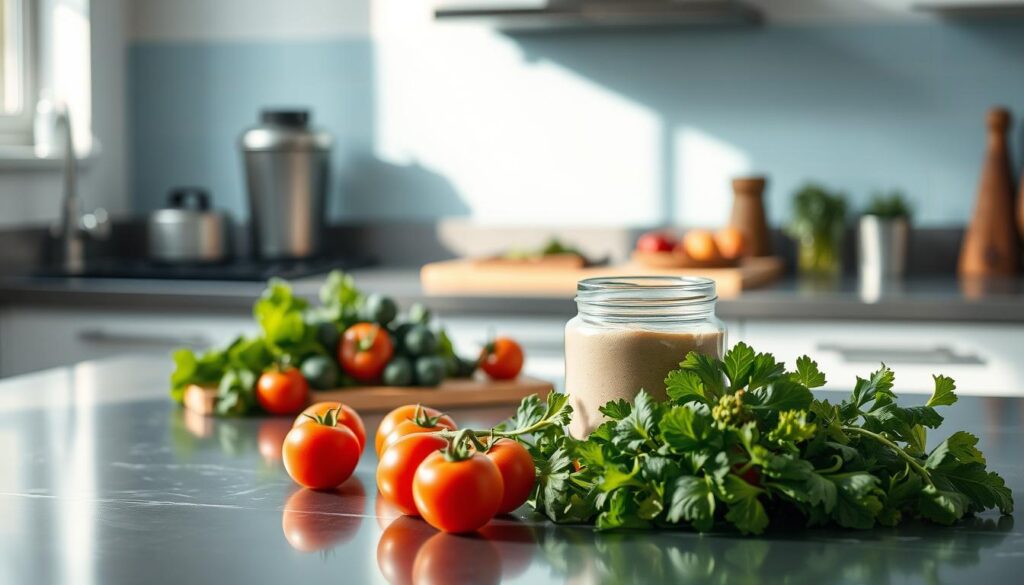
- Grilled salmon (25g per serving): Omega-3s reduce inflammation while amino acids rebuild tissue
- Lentil stir-fry (18g per cup): Plant-based option with iron for oxygen transport
- Greek yogurt parfait (20g): Casein protein provides slow-release recovery overnight
When I adjusted my post-yoga snack to include 30g of protein (hello, turkey-and-avocado roll-ups), my afternoon energy soared. One client reported similar results after adding a cottage cheese snack: “My evening workouts feel stronger now.”
| Meal Timing | Target (grams) | Example |
|---|---|---|
| Post-Workout | 25-30g | Chicken quinoa bowl |
| Dinner | 20-25g | Shrimp zucchini noodles |
| Snacks | 10-15g | Hard-boiled eggs + almonds |
For busy nights, try my 5-minute recipe: Blend silken tofu into pasta sauce for 14g of plant protein per cup. Pair with whole-grain noodles and spinach—it’s muscle support disguised as comfort food.
Turning Meal Prep into a Sustainable Lifestyle
Imagine opening your fridge to find meals that fuel your week without last-minute stress. That’s the reality for teacher and mom-of-three Jenna Hartley, who told me: “Meal prep stopped being a chore when I made it my Sunday self-care ritual.” Her secret? A flexible system that adapts to busy days while keeping her family excited about wholesome food.
Start with a weekly blueprint that balances structure and spontaneity:
| Day | Breakfast | Dinner |
|---|---|---|
| Monday | Overnight oats | Quinoa-stuffed peppers |
| Wednesday | Avocado toast | Sheet-pan salmon |
| Friday | Greek yogurt parfait | Build-your-own bowls |
Notice the pattern? Batch-cooked bases like quinoa or roasted veggies become multiple meals. Add fresh twists each day—a squeeze of lime here, a handful of herbs there. One dad in our online community shared: “My kids now beg for ‘surprise Fridays’ where we mix leftovers into new creations.”
Three rules for lasting success:
- Keep breakfasts grab-and-go (try egg muffins with spinach)
- Design dinner recipes that yield lunch portions
- Join local cooking swaps for recipe inspiration
When Austin nurse Marco Rodriguez started prepping chia pudding jars and avocado-chicken wraps, his 12-hour shifts became manageable. “I’m saving $200 a month and actually enjoying my meals,” he reported. That’s the power of turning prep into practice—not perfection.
What if every lunch could feel like a fresh discovery? Throughout this guide, we’ve explored how smart flavor boosts—like zesty dressings and spice blends—turn routine meals into exciting fuel. Remember Jenna’s freezer burrito system? Or Marco’s avocado-chicken wraps that saved his 12-hour shifts? These real-life wins prove simple tweaks create lasting momentum.
Let’s recap the essentials:
Balance is key. Aim for 20-30 grams protein per serving to support energy and recovery. Pair it with fiber-rich bases like cauliflower rice or wild blends. A tangy yogurt sauce or sprinkle of feta adds flair without derailing goals.
Your kitchen toolkit matters. Keep prepped dressings and spice mixes ready for grab-and-go assembly. Try my 3-ingredient sesame-ginger recipe on grain bowls—it transforms basics into craveable dishes in minutes.
Thank you for letting me share these strategies. Now it’s your turn! Whip up that curried chicken wrap or tofu scramble you bookmarked. Meal prep shouldn’t feel rigid—it’s a flexible way to nourish your busiest days.
Ready to begin? Start with one recipe this week. Your future self will thank you when lunchtime becomes something to savor, not survive.
Spicy Ginger Chicken & Mango Quinoa Bowls
A vibrant and nutritious bowl combining spicy ginger-marinated chicken, sweet mango, and fluffy quinoa, topped with a zesty peanut sauce. Perfect for a wholesome lunch or dinner.
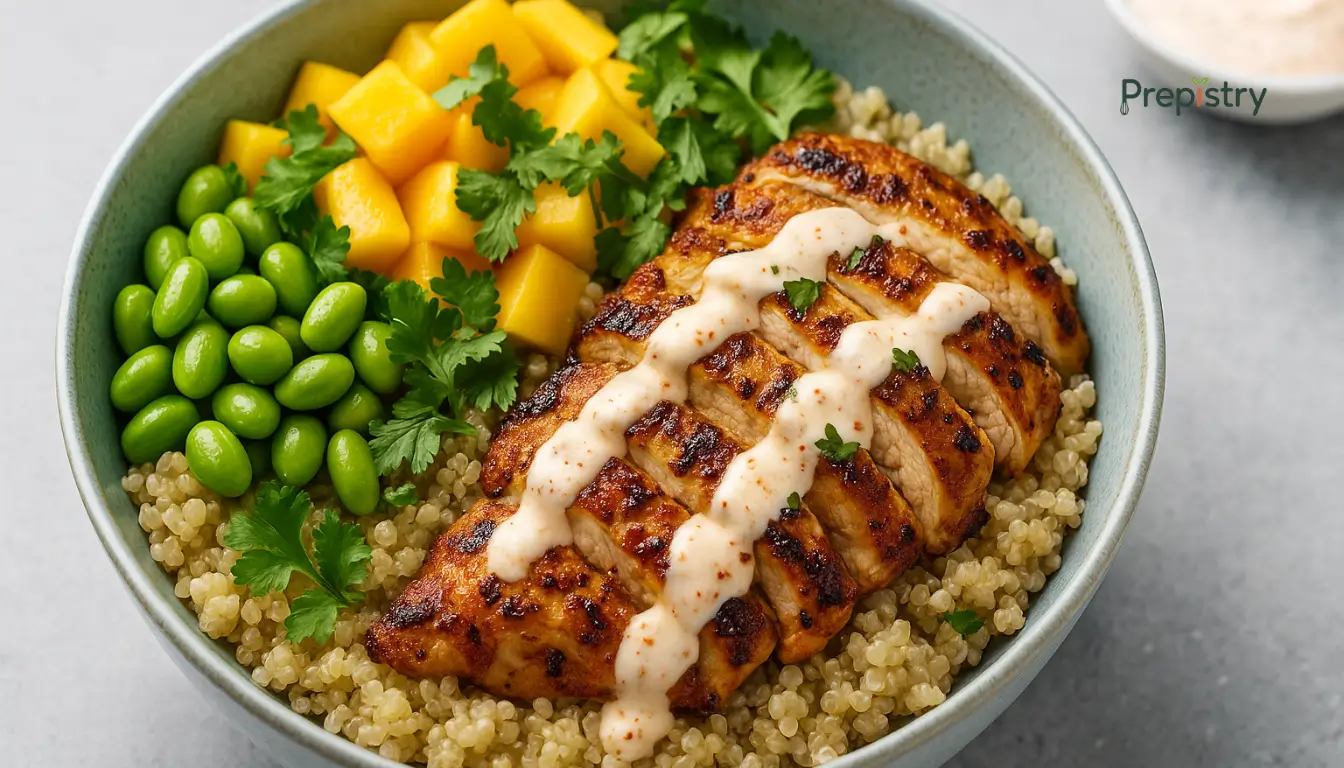
Nutrition Information
Equipment Needed
- Large skillet
- Medium saucepan
- Mixing bowls
- Cutting board
- Knife
Ingredients
-
2 boneless, skinless chicken breasts
-
1 tablespoon fresh ginger, grated
-
2 cloves garlic, minced
-
2 tablespoons soy sauce
-
1 tablespoon honey
-
1 tablespoon sriracha
-
1 cup quinoa
-
2 cups water
-
1 ripe mango, diced
-
1 red bell pepper, sliced
-
2 cups fresh spinach
-
1/4 cup chopped peanuts
-
2 green onions, sliced
-
1 lime, cut into wedges
-
Salt and pepper to taste
Instructions
Recipe Video
Spicy Ginger Chicken & Mango Quinoa Bowls Recipe
Learn how to make Spicy Ginger Chicken & Mango Quinoa Bowls—a perfect blend of heat and sweetness for a healthy meal.

